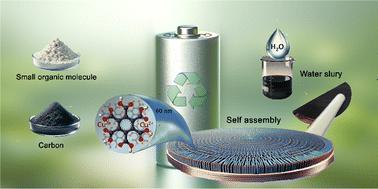当前位置:
X-MOL 学术
›
Energy Environ. Sci.
›
论文详情
Our official English website, www.x-mol.net, welcomes your
feedback! (Note: you will need to create a separate account there.)
Harnessing enhanced lithium-ion storage in self-assembled organic nanowires for batteries and metal-ion supercapacitors
Energy & Environmental Science ( IF 32.4 ) Pub Date : 2024-10-15 , DOI: 10.1039/d4ee02777a Ievgen Obraztsov, Rostislav Langer, Jean G. A. Ruthes, Volker Presser, Michal Otyepka, Radek Zbořil, Aristides Bakandritsos
Energy & Environmental Science ( IF 32.4 ) Pub Date : 2024-10-15 , DOI: 10.1039/d4ee02777a Ievgen Obraztsov, Rostislav Langer, Jean G. A. Ruthes, Volker Presser, Michal Otyepka, Radek Zbořil, Aristides Bakandritsos

|
Organic materials have emerged as highly efficient electrodes for electrochemical energy storage, offering sustainable solutions independent from non-renewable resources. In this study, we showcase that mesoscale engineering can dramatically transform the electrochemical features of a molecular organic carboxylic anode. Through a sustainable, energy-efficient and environmentally benign self-assembly strategy, we developed a network of organic nanowires formed during water evaporation directly on the copper current collector, circumventing the need for harmful solvents, typically employed in such processes. The organic nanowire anode delivers high capacity and rate, reaching 1888 mA h g−1 at 0.1 A g−1 and maintaining 508 mA h g−1 at a specific current of 10 A g−1. Moreover, it exhibits superior thermal management during lithiation in comparison to graphite and other organic anodes. Comprehensive electrochemical evaluations and theoretical calculations reveal rapid charge transport mechanisms, with lithium diffusivity rates reaching 5 × 10−9 cm2 s−1, facilitating efficient and rapid interactions with 24 lithium atoms per molecule. Integrated as the negative electrode in a lithium-ion capacitor, paired with a commercially available porous carbon, the cell delivers a specific energy of 156 W h kg−1 at a specific power of 0.34 kW kg−1 and 60.2 W h kg−1 at 19.4 kW kg−1, establishing a benchmark among state-of-the-art systems in the field. These results underscore the critical role of supramolecular organization for optimizing the performance of organic electrode materials for practical and sustainable energy storage technologies.
中文翻译:

在电池和金属离子超级电容器的自组装有机纳米线中利用增强的锂离子存储
有机材料已成为用于电化学储能的高效电极,提供独立于不可再生资源的可持续解决方案。在这项研究中,我们展示了中尺度工程可以显着改变分子有机羧酸阳极的电化学特性。通过可持续、节能且环保的自组装策略,我们开发了一种在水分蒸发过程中直接在铜集流体上形成的有机纳米线网络,从而避免了此类过程中通常使用的有害溶剂的需求。有机纳米线阳极具有高容量和速率,在 0.1 A g-1 时达到 1888 mA h g-1,在 10 A g-1 的比电流下保持 508 mA h g-1。此外,与石墨和其他有机阳极相比,它在锂化过程中表现出卓越的热管理。全面的电化学评估和理论计算揭示了快速电荷传输机制,锂扩散率达到 5 × 10-9 cm2 s-1,促进了每个分子与 24 个锂原子的高效快速相互作用。该电池作为负极集成在锂离子电容器中,与市售多孔碳配对,在 0.34 kW kg-1 的比功率下提供 156 W h kg-1 的比能量,在 19.4 kW kg-1 的比功率下提供 60.2 W h kg-1,在该领域最先进的系统中树立了标杆。 这些结果强调了超分子组织在优化有机电极材料性能方面的关键作用,以实现实用和可持续的储能技术。
更新日期:2024-10-15
中文翻译:

在电池和金属离子超级电容器的自组装有机纳米线中利用增强的锂离子存储
有机材料已成为用于电化学储能的高效电极,提供独立于不可再生资源的可持续解决方案。在这项研究中,我们展示了中尺度工程可以显着改变分子有机羧酸阳极的电化学特性。通过可持续、节能且环保的自组装策略,我们开发了一种在水分蒸发过程中直接在铜集流体上形成的有机纳米线网络,从而避免了此类过程中通常使用的有害溶剂的需求。有机纳米线阳极具有高容量和速率,在 0.1 A g-1 时达到 1888 mA h g-1,在 10 A g-1 的比电流下保持 508 mA h g-1。此外,与石墨和其他有机阳极相比,它在锂化过程中表现出卓越的热管理。全面的电化学评估和理论计算揭示了快速电荷传输机制,锂扩散率达到 5 × 10-9 cm2 s-1,促进了每个分子与 24 个锂原子的高效快速相互作用。该电池作为负极集成在锂离子电容器中,与市售多孔碳配对,在 0.34 kW kg-1 的比功率下提供 156 W h kg-1 的比能量,在 19.4 kW kg-1 的比功率下提供 60.2 W h kg-1,在该领域最先进的系统中树立了标杆。 这些结果强调了超分子组织在优化有机电极材料性能方面的关键作用,以实现实用和可持续的储能技术。


















































 京公网安备 11010802027423号
京公网安备 11010802027423号